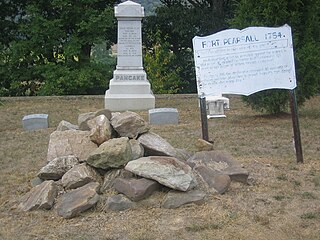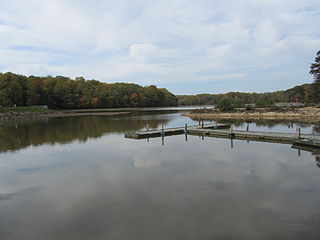
Fairfax County, officially the County of Fairfax, is a county in the Commonwealth of Virginia. It is part of Northern Virginia and borders both the city of Alexandria and Arlington County and forms part of the suburban ring of Washington, D.C., the nation's capital. The county is predominantly suburban in character with some urban and rural pockets.

Mount Vernon is a census-designated place (CDP) and unincorporated community in Fairfax County, Virginia, United States. The population was 12,914 at the 2020 census. Primarily due to its historical significance and natural recreation and beauty, the Mount Vernon area receives over one million tourists each year.

Mount Vernon is the former residence and plantation of George Washington, a Founding Father, commander of the Continental Army in the Revolutionary War, and the first president of the United States, and his wife, Martha. An American landmark, the estate lies on the banks of the Potomac River in Fairfax County, Virginia, approximately 15 miles south of Washington, D.C..

Northern Virginia, locally referred to as NOVA or NoVA, comprises several counties and independent cities in the Commonwealth of Virginia in the United States. The region radiates westward and southward from Washington, D.C. With 3,257,133 people as of 2023 U.S. Census Bureau estimates, the region includes 37.37 percent of Virginia's total population. It is the most populous region of both Virginia and the Washington metropolitan area.

William Fitzhugh was an American planter, legislator and patriot during the American Revolutionary War who served as a delegate to the Continental Congress for Virginia in 1779, as well as many terms in the House of Burgesses and both houses of the Virginia General Assembly following the Commonwealth's formation. His Stafford County home, Chatham Manor, is on the National Register for Historic Places and serves as the National Park Service Headquarters for the Fredericksburg and Spotsylvania National Military Park.

Thomas Fairfax, 6th Lord Fairfax of Cameron, was a Scottish peer. The only resident peer in late colonial-era America, Fairfax owned a vast territory of land in Virginia known as the Northern Neck Proprietary, which his ancestors had acquired in 1649 by a land grant from King Charles II of England. The proprietary originally spanned roughly 5 million acres, and Fairfax administered it from his wilderness estate in Greenway Court, Virginia. He owned several hundred slaves on some 30 farms and derived much of his income from their labor.
Fort Belvoir is a United States Army installation and a census-designated place (CDP) in Fairfax County, Virginia, United States. It was developed on the site of the former Belvoir plantation, seat of the prominent Fairfax family for whom Fairfax County was named. It was known as Camp A. A. Humphreys from 1917 to 1935 and Fort Belvoir afterward.

Fort Pearsall was an early frontier fort constructed in 1756 in Romney, West Virginia to protect local settlers in the South Branch Potomac River valley against Native American raids. The area around present-day Romney had been settled as early as 1725 by hunters and traders in the valley.

Accotink Creek is a 25.0-mile-long (40.2 km) tributary stream of the Potomac River in Fairfax County, Virginia, in the United States. At Springfield, Virginia, Accotink Creek is dammed to create Lake Accotink. The stream empties into the Potomac at Gunston Cove's Accotink Bay, to the west of Fort Belvoir.

Woodlawn is a historic house located in Fairfax County, Virginia. Originally a part of Mount Vernon, George Washington's historic plantation estate, it was subdivided in the 19th century by abolitionists to demonstrate the viability of a free labor system. The address is now 9000 Richmond Highway, Alexandria, Virginia, but due to expansion of Fort Belvoir and reconstruction of historic Route 1, access is via Woodlawn Road slightly south of Jeff Todd Way/State Route 235. The house is a designated National Historic Landmark, primarily for its association with the Washington family, but also for the role it played in the historic preservation movement. It is now a museum property owned and managed by the National Trust for Historic Preservation.

State Route 235 is a primary state highway in the U.S. state of Virginia. The state highway runs 5.05 miles (8.13 km) between intersections with U.S. Route 1 in Fort Belvoir and Hybla Valley. SR 235 forms a southeast loop off of US 1 through the community of Mount Vernon in southeastern Fairfax County, connecting US 1 with Mount Vernon, the plantation home of George Washington, and the southern end of the George Washington Memorial Parkway.

Lake Accotink is a reservoir in North Springfield in Fairfax County, Virginia, United States. Lake Accotink is formed by the damming of Accotink Creek. The lake is surrounded by Lake Accotink Park.

Vaucluse was a villa in Fairfax County, Virginia. Located three miles (5 km) from Alexandria and 10 miles (16 km) from Washington, D.C., on a hill near the Virginia Theological Seminary. It was owned first by Dr. James Craik, and later by the Fairfax family, the first being Thomas Fairfax, 9th Lord Fairfax of Cameron.

William Fairfax (1691–1757) was a political appointee of the British Crown in several colonies as well as a planter and politician in the Colony of Virginia. Fairfax served as Collector of Customs in Barbados, Chief Justice and governor of the Bahamas; and Customs agent in Marblehead, Massachusetts, before being reassigned to the Colony of Virginia.
Mount Vernon is a magisterial district in the southeastern sector of Fairfax County, Virginia which encompasses the area along the Potomac River, Mount Vernon, Fort Belvoir, and Gunston Hall. It includes the CDPs of Belle Haven, New Alexandria, Huntington, Groveton, Hybla Valley, Fort Hunt, Mount Vernon, Fort Belvoir, Mason Neck, Lorton, and Newington, Virginia. The office of the district is on 2511 Parkers Lane, Alexandria, VA 22306; Annual Town Meetings are held at Mount Vernon High School's "Little Theatre". As of 2010 the population was 127,637. Dan Storck is the current supervisor. Mateo Dunne is the current school board member.

Wappocomo is a late 18th-century Georgian mansion and farm overlooking the South Branch Potomac River north of Romney, Hampshire County, West Virginia, USA. It is located along Cumberland Road and the South Branch Valley Railroad.
Hope Park was an 18th and 19th-century plantation in Fairfax County in the U.S. state of Virginia, where Dr. David Stuart (1753–1814), an old friend of and correspondent with George Washington lived with his wife, Eleanor Calvert Custis (1758–1811), and family. It was approximately 5 miles (8.0 km) southwest of Fairfax Court House.
Ebenezer Erskine Mason was a farmer who also served as a local magistrate and one of Fairfax County, Virginia's two delegates to the Wheeling Convention in 1861 which created the Restored Government of Virginia and led to the creation of the state of West Virginia.
Ludwell Lee was a prominent American lawyer and planter who served in both houses of the Virginia General Assembly representing Prince William and Fairfax Counties and rose to become the Speaker of the Virginia Senate. Beginning in 1799, following the death of his first wife, Lee built Belmont Manor, a planation house in Loudoun County, Virginia, which today is on the National Register of Historic Places.




















